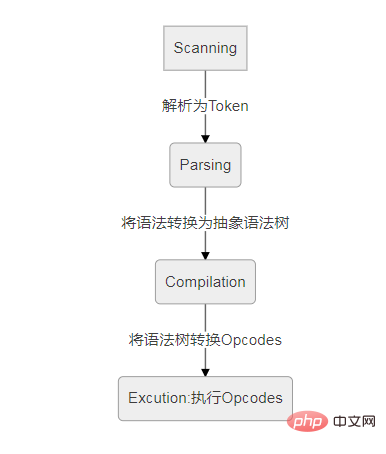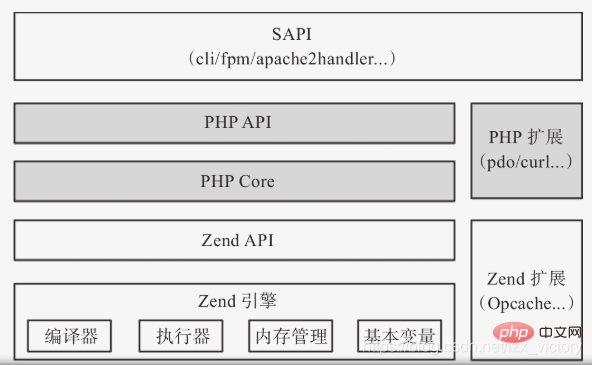How to understand PHP architecture layout
This article will introduce you to the PHP architecture layout. It has certain reference value. Friends in need can refer to it. I hope it will be helpful to everyone.

Execution process
It can be seen from the above figure that there are mainly four stages from parsing PHPCode to execution.

To obtain token, you can obtain token information through the Token_get_all('<?php echo "str";>') function.
Abstract syntax tree mainly decouples the interpreter and compiler.
The instructions that opcodes are ultimately executed, such as ZEND_ECHO: are essentially a corresponding C function.
Architecture structure

The Zend layer provides some basic memory management and data structures for the upper PHP layer.
The SAPI layer communicates with the server for the upper layer, encapsulating different communication types. cgi, fast-cgi, cli, etc.
Directory structure
sapi
stores the upper-layer API interaction forms supported by different environments, and implements different input and output forms.
Zend
Stores PHP-related core code, memory management, etc. as mentioned above.
main
is responsible for the entrance to interact with the Zend layer, and Some hook functions.
ext
Mainly expand related directories. Generate custom modules through the ext_skel command. They will be installed in this directory by default.
TSRM
Directories related to thread resource management, generally only when used in conjunction with Apache, will involve code related to thread resource management.
Those related to Nginx will generally only use the FastCGI protocol and not involve it. TSRM module.
Recommended learning: php video tutorial
The above is the detailed content of How to understand PHP architecture layout. For more information, please follow other related articles on the PHP Chinese website!

Hot AI Tools

Undresser.AI Undress
AI-powered app for creating realistic nude photos

AI Clothes Remover
Online AI tool for removing clothes from photos.

Undress AI Tool
Undress images for free

Clothoff.io
AI clothes remover

AI Hentai Generator
Generate AI Hentai for free.

Hot Article

Hot Tools

Notepad++7.3.1
Easy-to-use and free code editor

SublimeText3 Chinese version
Chinese version, very easy to use

Zend Studio 13.0.1
Powerful PHP integrated development environment

Dreamweaver CS6
Visual web development tools

SublimeText3 Mac version
God-level code editing software (SublimeText3)

Hot Topics
 1378
1378
 52
52
 PHP 8 JIT (Just-In-Time) Compilation: How it improves performance.
Mar 25, 2025 am 10:37 AM
PHP 8 JIT (Just-In-Time) Compilation: How it improves performance.
Mar 25, 2025 am 10:37 AM
PHP 8's JIT compilation enhances performance by compiling frequently executed code into machine code, benefiting applications with heavy computations and reducing execution times.
 PHP Secure File Uploads: Preventing file-related vulnerabilities.
Mar 26, 2025 pm 04:18 PM
PHP Secure File Uploads: Preventing file-related vulnerabilities.
Mar 26, 2025 pm 04:18 PM
The article discusses securing PHP file uploads to prevent vulnerabilities like code injection. It focuses on file type validation, secure storage, and error handling to enhance application security.
 OWASP Top 10 PHP: Describe and mitigate common vulnerabilities.
Mar 26, 2025 pm 04:13 PM
OWASP Top 10 PHP: Describe and mitigate common vulnerabilities.
Mar 26, 2025 pm 04:13 PM
The article discusses OWASP Top 10 vulnerabilities in PHP and mitigation strategies. Key issues include injection, broken authentication, and XSS, with recommended tools for monitoring and securing PHP applications.
 PHP Authentication & Authorization: Secure implementation.
Mar 25, 2025 pm 03:06 PM
PHP Authentication & Authorization: Secure implementation.
Mar 25, 2025 pm 03:06 PM
The article discusses implementing robust authentication and authorization in PHP to prevent unauthorized access, detailing best practices and recommending security-enhancing tools.
 PHP Encryption: Symmetric vs. asymmetric encryption.
Mar 25, 2025 pm 03:12 PM
PHP Encryption: Symmetric vs. asymmetric encryption.
Mar 25, 2025 pm 03:12 PM
The article discusses symmetric and asymmetric encryption in PHP, comparing their suitability, performance, and security differences. Symmetric encryption is faster and suited for bulk data, while asymmetric is used for secure key exchange.
 What is the purpose of prepared statements in PHP?
Mar 20, 2025 pm 04:47 PM
What is the purpose of prepared statements in PHP?
Mar 20, 2025 pm 04:47 PM
Prepared statements in PHP enhance database security and efficiency by preventing SQL injection and improving query performance through compilation and reuse.Character count: 159
 PHP API Rate Limiting: Implementation strategies.
Mar 26, 2025 pm 04:16 PM
PHP API Rate Limiting: Implementation strategies.
Mar 26, 2025 pm 04:16 PM
The article discusses strategies for implementing API rate limiting in PHP, including algorithms like Token Bucket and Leaky Bucket, and using libraries like symfony/rate-limiter. It also covers monitoring, dynamically adjusting rate limits, and hand
 ACID vs BASE Database: Differences and when to use each.
Mar 26, 2025 pm 04:19 PM
ACID vs BASE Database: Differences and when to use each.
Mar 26, 2025 pm 04:19 PM
The article compares ACID and BASE database models, detailing their characteristics and appropriate use cases. ACID prioritizes data integrity and consistency, suitable for financial and e-commerce applications, while BASE focuses on availability and




